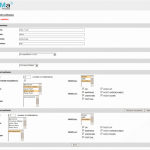June 2010: In a large and distributed environment, multi channel alerts for hundreds of users can get complicated. Indeed that’s where NoMa came in handy for one of our longstanding clients. With no less than 60 alert definitions, NoMa had been managing Nagios alerts for the corporation’s 1000+ users dependent on central services, across their 80+ remote sites worldwide.
All was working well, but as always things can work better. One pesky characteristic was that if a highly interconnected component were to fail, not only would the admins receive that alert, but they would also receive individual alerts for all the other services and components that were subsequently affected. This domino effect inundated the admins with messages that ultimately stemmed from the same issue. So the proposal was put forward – how about bundling all related errors into one summary message, but still be able to individually (de)activate each alert?
Consultant William took on the challenge, thereby setting the foundations of NoMa’s latest release, version 1.0.5. By transferring t
All in all, thanks to their sponsorship and close cooperation, NoMa will soon be available as v 1.0.5 equipped with greater flexibility. As the biggest contributor to NoMa, a company representative even presented the project at the OSMC 2009. Check out the presentation for more info and keep an eye on netways.org for the official release coming soon!
NETWAYS Blog
Weekly Snap: CSS2 floats to AKCP converters, OSDC & NETWAYS Jobs

The development team kicked off with Marius‘ CSS2 tip for floating page layouts. First in ‘clearfix’, inserting a ‘clear’ after a float, second with ‘overflow:hidden|auto’ for a new display context. This ensures that the ‘clear’ doesn’t creep into the entire page, staying in the desired area automatically without needing to create strange margins.
On the monitoring front we reflected on the March project of the month, while Martin showed us how to integrate third-party sensors for those tricky industrial monitoring needs. From temperature sensors for pipelines or outdoors, to absolute pressure measurement and CO ² sensors – all these industrial sensors can be converted into electricity or voltage so their results can be transmitted over long distances to an AKCP sensorProbe2 which then forwards them on via SNMP to any monitoring software such as Nagios and Icinga.
Following on, Manuela reminded early birds to snap up the last ticket specials for the OSDC coming up on 23 – 24 June, while Karo announced our search for 3 new enthusiastic professionals to join the NETWAYS team. Project managers, Linux consultants and bookkeepers are welcome to apply, as are any would-be apprentices for software development.
Of course, no April could begin without a fool on the 1st day of the month – check out the newest voice notification services we’re offering through our partner call center in India and enjoy!
Project of the Month: Mule for Enhanced Distributed Monitoring
March 2010: When our customer needed to centrally monitor the latency of IT services across their 3 offices in Germany, America and Sweden, they were looking for a speedier alternative to their existing solution. Remote monitoring was not meeting their standards, as relying on an international link was all but efficient.
So Bernd came in with an ESB idea. Implementing Mule in their 3 locations, the set up included a server based in Germany and satellites in America and Sweden. The satellites read status and performance data from their file systems to send to the server, which in turn stored the data in an external command file. In processing commands, the server then read from NDO/IDO-DB, reviewed the content and sent the commands to the corresponding satellites. These satellites then also stored the data in an external command file.
Supported by Mule ESB, the satellites could be connected far more tightly and information could flow smoother. Moreover, transforming their makeshift bundle of scripts into a centralised system also meant the entire process itself could be more easily monitored with the handy check_jmx4perl. All in all, a more dynamic and flexible solution thanks to Mule.
Gesunde Datenbanküberwachung mit Nagios
In vielen öffentlichen Einrichtungen wird die kostengünstige Monitoring Lösung Nagios geschätzt. So auch bei unserem Kunden der Gesundheit Nordhessen Holding AG. Besonders positiv fällt immer wieder die Möglichkeit ins Gewicht eigene Erweiterungen oder Anpassungen vorzunehmen und so auch auf spezielle Anforderungen einzugehen. In diesem Fall ging es besonders um einige Eigenheiten bei der Überwachung von verschiedenen Datenbanksystemen (MySQL, Oracle und MSSQL).
Wir haben in Kassel schon im letzten Jahr geholfen, und möchten uns hier noch ein mal für die gute Zusammenarbeit bedanken.
RT-Hosting für das Europäische Patentamt
Vor einiger Zeit hatten wir das Europäische Patentamt schon einmal mit Consulting zum Request Tracker vor Ort in Wien unterstützt. Das Tool hat sich für die interne und externe Kommunikation bewährt, jedoch wurde mittlerweile entschieden, dass es sinnvoller ist den Betrieb auszulagern um sich nicht um dessen Details kümmern zu müssen.
Das Setup wird in unserem Rechenzentrum auf einer virtuellen Maschine betrieben und der Speicherplatz wird auf einem NetApp SAN zur Verfügung gestellt. Durch diesen Aufbau können bei Bedarf die Ressourcen flexibel erweitert werden.
Durch die eingesetzte SSL Verschlüsselung ist auch der Zugriff von externen Quellen sicher. Wir freuen uns über das gewährte Vertrauen und eine weiterhin gute Zusammenarbeit.


















